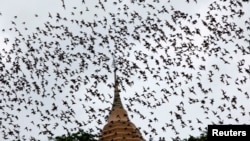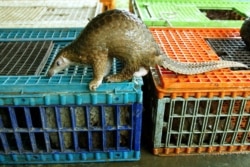Scientists hunting the origins of the virus behind COVID-19 and clues for how to prevent the next pandemic say a growing body of evidence argues for expanding the search beyond China into Southeast Asia.
Since the first confirmed outbreak of COVID-19 put the eastern Chinese city of Wuhan on the world map in December 2019, researchers looking for the source of the virus that causes the disease, SARS-CoV-2, have been training their gaze on China itself.
The pathogen’s closest known relative, sharing some 96% of its genome, is another coronavirus found early last year in the southern province of Yunnan.
But a spate of recent studies has found more viruses nearly as similar to SARS-CoV-2 as the one in Yunnan further afield, in Thailand and Cambodia.
Virologists on a recent mission to Wuhan sponsored by the World Health Organization to trace the roots of COVID-19 also say that the next phase of the hunt should add Southeast Asia to the field.
Their advice is to follow the bats. Some species are well-known reservoirs of the coronavirus family and leading candidates for SARS-CoV-2 fountainhead.
Bat signals
Scientists have already identified more than 100 SARS-related coronaviruses in bats across China, said Peter Daszak, a virologist who joined the WHO trip.
“But we haven’t done enough work in Myanmar, Laos and Vietnam to really say that there aren’t even more in those countries,” he told VOA.
“When you plot out on a map where the bats live that carry these viruses, you start to see that those countries on the southern border of China have even more diversity of bats and likely even more diversity of viruses. So, it may be that the origin really was in Yunnan province, but my best guess is that we need to look in Myanmar, Laos, Vietnam and then even farther south into the whole region of Southeast Asia as a potential hotspot.”
China has refused to hand over raw data on some of the earliest patients of COVID-19. Even so, Daszak said, the Chinese scientists and WHO delegation agreed that SARS-CoV-2’s most likely route into humans was from bats via some sort of farmed wildlife as intermediary.
Early last year scientists from China and Australia reported finding viruses matching SARS-CoV-2 by more than 90% in Malayan pangolins — a potential intermediary hunted for their scales and meat — that had been smuggled into southern China from Southeast Asia.
A few months later, scientists found viruses akin to SARS-CoV-2 lurking in horseshoe bats that had been collected in Cambodia and freeze-dried more than a decade ago. They said in their report that the discovery “indicates that SARS-CoV-2-related viruses have a much wider geographic distribution than previously understood and suggests that Southeast Asia represents a key area to consider in the ongoing search for the origins of SARS-CoV-2.”
Then, in February, scientists in Thailand also found viruses closely matching SARS-CoV-2 in a colony of bats not far from Bangkok, and antibodies effective against SARS-CoV-2 itself in a smuggled pangolin seized by local authorities in the country’s south, near Malaysia.
It’s relative
Supaporn Wacharapluesadee, a virologist with the Thai Red Cross Emerging Infectious Diseases Health Science Center at Chulalongkorn University in Bangkok, who took part in the last study, called it an “important discovery in the search for the origins of SARS-CoV-2.”
She said the search for those origins should lead wherever the bats that host its closest known relatives live.
“For example, if we find SARS-CoV-2-related virus in horseshoe bats in China, that means if you find horseshoe bats in other countries the virus can [potentially] be found in other countries also,” she told VOA.
To narrow in further on the ultimate source of SARS-CoV-2, virus hunters are looking for matches even closer than the 96% of the strain found in Yunnan last year. The strains found in Thailand and Cambodia range in likeness from roughly 91% to 93%.
But given the population density and abundance of bat species in Southeast Asia, the team that found the SARS-CoV-2 relative in Thailand says the sub-region may be “a more likely hotspot for such viruses” than China and worth added attention.
Chee Wah Tan, a senior research fellow at the Duke-National University of Singapore Medical School and another member of the team, said the search should take in the region’s bats and likely intermediaries alike.
The strains found in Thailand and Cambodia, “could be the ancestor or something close to the ancestor of SARS-COVID-2,” he told VOA.
“That’s why now maybe more work has to be carried out on this region to see whether we can identify any intermediate hosts that carry [a virus with] 99.9% genome similarity to the SARS-COVID-2.”
In pursuit
That work has already begun.
Daszak, president of EcoHeatlh Alliance, a U.S. non-profit fighting the threat of emerging diseases from animals, said his group is just getting started on surveillance work in Laos, Myanmar and Vietnam — which all border China — for signs of SARS-CoV-2 in bats. They’ve been doing similar work with coronaviruses in Thailand and Malaysia for a few years already, as have local scientists there and elsewhere.
His hope is that Beijing steps up its own surveillance and testing of wildlife farms and markets on its side of the border in southern China, as it has tentatively agreed to do. He also hopes to work with local police to test the animals they pluck from the illegal wildlife traffickers who cross those borders.
Daszak is not expecting any quick answers to exactly where SARS-CoV-2 began and how it jumped to humans. He said the search for the origins of the SARS virus took some five years and that scientists still aren’t sure where the Ebola virus came from more than four decades after spotting it in Africa.
The search for those answers is far more than academic. By tracing SARS-CoV-2 back to its roots, scientists hope to find the other animal viruses and pathways most likely to cause the next pandemic and step in before they do.
“It’s a bit like disrupting terrorist cells,” Daszak said. “When you hear rumors of a terrorist attack, you don’t wait for the attack, you go out there and you disrupt that network, and you close it down. That’s what we need to do with pandemics.”











